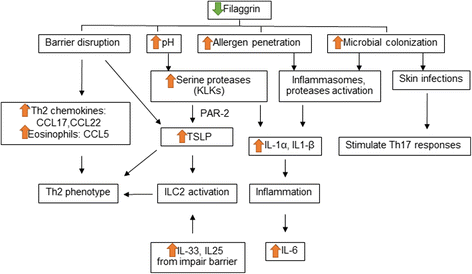The etiopathogenesis of atopic dermatitis: barrier disruption, immunological derangement, and pruritus
- PMID: 29259713
- PMCID: PMC5725646
- DOI: 10.1186/s41232-017-0044-7
The etiopathogenesis of atopic dermatitis: barrier disruption, immunological derangement, and pruritus
Abstract
Atopic dermatitis (AD) is a common chronic skin inflammatory disorder characterized by recurrent eczema accompanied by an intractable itch that leads to an impaired quality of life. Extensive recent studies have shed light on the multifaceted pathogenesis of the disease. The complex interplay among skin barrier deficiency, immunological derangement, and pruritus contributes to the development, progression, and chronicity of the disease. Abnormalities in filaggrin, other stratum corneum constituents, and tight junctions induce and/or promote skin inflammation. This inflammation, in turn, can further deteriorate the barrier function by downregulating a myriad of essential barrier-maintaining molecules. Pruritus in AD, which may be due to hyperinnervation of the epidermis, increases pruritogens, and central sensitization compromises the skin integrity and promotes inflammation. There are unmet needs in the treatment of AD. Based on the detailed evidence available to date, certain disease mechanisms can be chosen as treatment targets. Numerous clinical trials of biological agents are currently being conducted and are expected to provide treatments for patients suffering from AD in the future. This review summarizes the etiopathogenesis of the disease and provides a rationale for choosing the novel targeted therapy that will be available in the future.
Keywords: Adaptive; Atopic dermatitis; Filaggrin; Immunology; Innate; Pathogenesis.
Figures



Similar articles
-
Basics and recent advances in the pathophysiology of atopic dermatitis.J Dermatol. 2021 Feb;48(2):130-139. doi: 10.1111/1346-8138.15664. Epub 2020 Oct 29. J Dermatol. 2021. PMID: 33118662 Review.
-
Atopic dermatitis and the stratum corneum: part 1: the role of filaggrin in the stratum corneum barrier and atopic skin.J Clin Aesthet Dermatol. 2013 Oct;6(10):16-22. J Clin Aesthet Dermatol. 2013. PMID: 24155988 Free PMC article.
-
Atopic dermatitis and the stratum corneum: part 2: other structural and functional characteristics of the stratum corneum barrier in atopic skin.J Clin Aesthet Dermatol. 2013 Nov;6(11):49-54. J Clin Aesthet Dermatol. 2013. PMID: 24307926 Free PMC article.
-
Epidermal tight junction barrier function is altered by skin inflammation, but not by filaggrin-deficient stratum corneum.J Dermatol Sci. 2015 Jan;77(1):28-36. doi: 10.1016/j.jdermsci.2014.11.007. Epub 2014 Nov 22. J Dermatol Sci. 2015. PMID: 25511077
-
Role of Antimicrobial Peptides in Skin Barrier Repair in Individuals with Atopic Dermatitis.Int J Mol Sci. 2020 Oct 14;21(20):7607. doi: 10.3390/ijms21207607. Int J Mol Sci. 2020. PMID: 33066696 Free PMC article. Review.
Cited by
-
Equine keratinocytes in the pathogenesis of insect bite hypersensitivity: Just another brick in the wall?PLoS One. 2022 Aug 1;17(8):e0266263. doi: 10.1371/journal.pone.0266263. eCollection 2022. PLoS One. 2022. PMID: 35913947 Free PMC article.
-
Management of Atopic Dermatitis: The Role of Tacrolimus.Cureus. 2022 Aug 18;14(8):e28130. doi: 10.7759/cureus.28130. eCollection 2022 Aug. Cureus. 2022. PMID: 35990561 Free PMC article. Review.
-
Barrier Impairment and Type 2 Inflammation in Allergic Diseases: The Pediatric Perspective.Children (Basel). 2021 Dec 9;8(12):1165. doi: 10.3390/children8121165. Children (Basel). 2021. PMID: 34943362 Free PMC article. Review.
-
The causal relationship and potential mediators between plasma lipids and atopic dermatitis: a bidirectional two-sample, two-step mendelian randomization.Lipids Health Dis. 2024 Jun 22;23(1):191. doi: 10.1186/s12944-024-02134-9. Lipids Health Dis. 2024. PMID: 38909247 Free PMC article.
-
Dictamnus dasycarpus Turcz. Root Bark Improves Skin Barrier Function and Symptoms of Atopic Dermatitis in Mice.Int J Mol Sci. 2024 Dec 7;25(23):13178. doi: 10.3390/ijms252313178. Int J Mol Sci. 2024. PMID: 39684888 Free PMC article.
References
Publication types
LinkOut - more resources
Full Text Sources
Other Literature Sources
Research Materials

